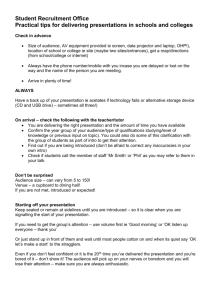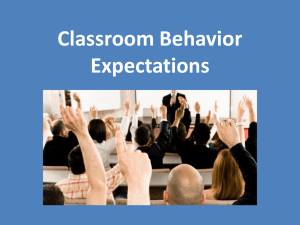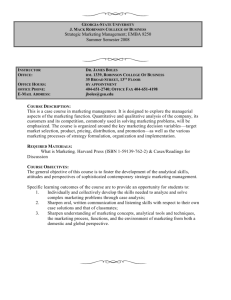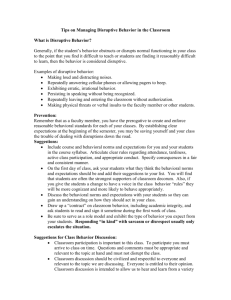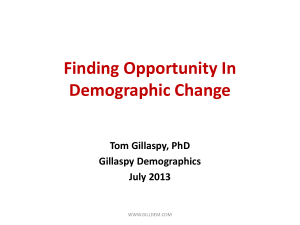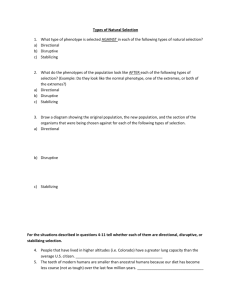B2B or B2C? Prioritizing the Selection of Target Markets for Finished
advertisement
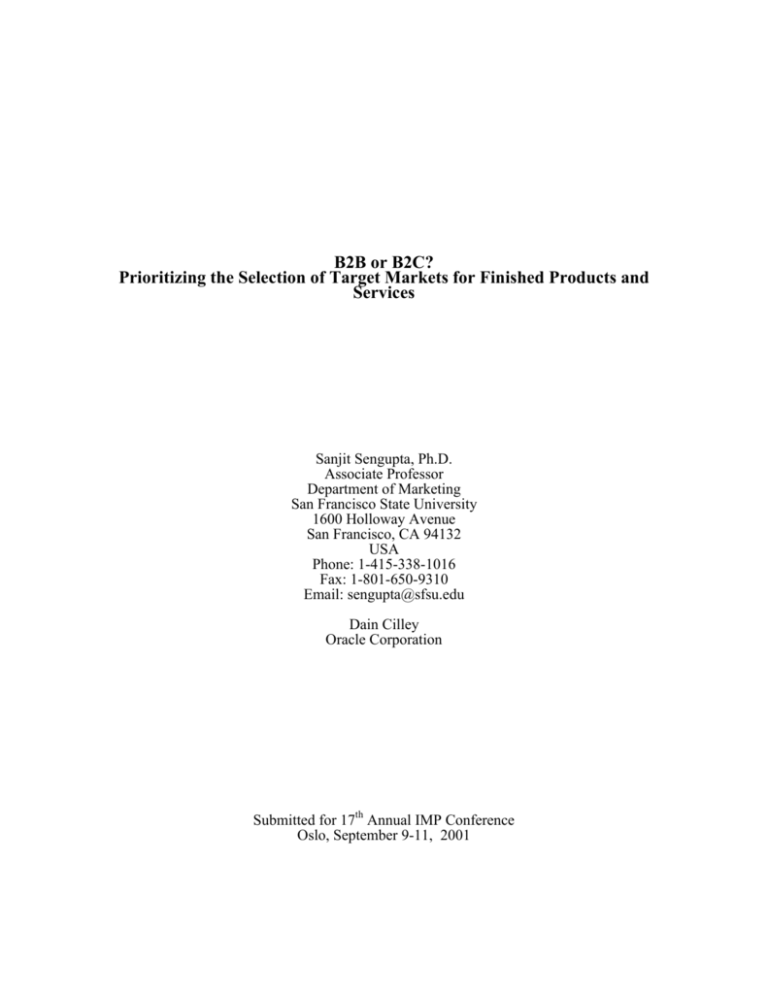
B2B or B2C? Prioritizing the Selection of Target Markets for Finished Products and Services Sanjit Sengupta, Ph.D. Associate Professor Department of Marketing San Francisco State University 1600 Holloway Avenue San Francisco, CA 94132 USA Phone: 1-415-338-1016 Fax: 1-801-650-9310 Email: sengupta@sfsu.edu Dain Cilley Oracle Corporation Submitted for 17th Annual IMP Conference Oslo, September 9-11, 2001 A key strategic question for any business, established or startup, is which target market(s) should it serve with a new product or service. At the highest level of market aggregation, a basic choice for businesses offering finished products or services is whether to target the business market (organizations) or the consumer market (individuals and households). Finished products and services, unlike raw materials or components, are used by end-users, either for their personal consumption or in performance of their work duties. In the parlance of e-commerce, the question is B2B or B2C, and in what order? This is a timely and relevant research issue because of the high failure rates of e-commerce businesses during the past two years (Hamilton and Mangalindan 2000). Established "bricks and mortar" businesses have struggled with this issue. The Apple Newton, the first Personal Digital Assistant in 1993, received a negative reaction from the consumer market and was eventually withdrawn (Carlton 1998). The Kodak Photo CD initially received a lukewarm reception from the consumer market and had to be repositioned for the business market (Rigdon 1992). These problems occurred, notwithstanding Apple and Kodak's prior history and competence in the consumer market. In contrast, Palm has had much more success with the business market (Narisetti 1997) before making a strong transition to the mainstream consumer market (Saunier 1998). Nextel followed a similar path in its transition from business to consumer markets in the mobile wireless business (Mehta 1997). The Internet has provided a variation to the above approach. Many online software and service providers seem to target both businesses and consumers simultaneously. While many of these products or services are offered free to consumers, profits are made on sales to business customers. Microsoft and Netscape let consumers download their browser free while charging licensing fees to business users (Cusumano and Yoffie 1998). The idea here is to generate wordof-mouth buzz and market share in the consumer market so that these consumers, in their workplace settings, will demand the same product from their employers. In this scenario, targeting the consumer market paves the way for success in the business market, which is often more profitable. While many dot-coms started and failed as B2C web sites, they have quickly 1 transformed themselves into B2B business models (Elgin 2000). Target market choices made purely on the basis of prior history, or the flavor-of-the-month, seem destined to fail. In the academic literature on business and marketing strategy, the factors that have been identified as influencing target market decisions are (a) target market attractiveness (size, growth, gross margins), and (b) firm capabilities and resources (Cooper and Kleinschmidt 1995). A firm launching a new, finished product or service without resource constraints, would probably target both business and consumer markets simultaneously. However, most firms experience some resource constraints, making prioritization of target markets essential. While the firm could do a financial analysis of the relative attractiveness of the business versus consumer market, such analysis is highly dependent upon the availability of data and the quality of assumptions made. Where such analysis fails to provide insight, this paper seeks to provide managerial guidelines on how to approach the problem of prioritizing business versus consumer markets for finished goods and services. Conceptual Framework and Hypotheses We seek to introduce two new variables in trying to explain the successful commercialization of finished goods and services, type of technology, and word-of-mouth influence. With regard to type of technology, we use Christiansen’s conceptualization of sustaining versus disruptive technologies (Christiansen 1997). A sustaining technology produces new products or services that provide performance benefits to existing customers. A disruptive technology produces new products and services that are initially inferior to an existing sustaining technology. Over time the performance of a disruptive technology improves until it poses a significant threat to the existing sustaining technology. An example of this is HP’s inkjet printer technology, which, at the time of its introduction, was disruptive to HP’s laser printer technology (Christiansen 1997). The threat of disruptive technology to sustaining technology can be represented graphically as follows: 2 Sustaining Performance Disruptive Market Needs t Time Source: Christiansen (1997) As the above diagram shows, products based on the disruptive technology are inferior and cheaper in comparison with the products based on the sustaining technology. Christiansen’s research reveals that sustaining technologies are more likely to be introduced by established incumbents while disruptive technologies are more likely to be introduced by new entrants. Prior to time “t” on the x-axis, established firms focused on sustaining technologies ignore the threat of substitutes because their existing customers see little need for the inferior product. Thus, the pioneers of the disruptive technology have to find new customers who may find value in a different performance attribute than the existing customers of established firms. Markets for the products of disruptive technology are unknowable in advance, therefore, financial analysis of the opportunity is not feasible. Rather, the market for a disruptive product or service has to evolve through a process of trial and error. The new entrant improves on the disruptive technology 3 through trial and error with new customers and, at some point, it can be introduced to the existing customers of the established companies as a more cost-effective solution to their needs. By this time, it is usually too late for the established companies to react and the market is pulled out from under them. This happened, for example, to Encylopaedia Brittanica’s bound volumes due to the improvements in Microsoft’s Encarta CDROM (Evans and Wurster 1997). Those established companies that anticipate, embrace and harness the disruptive technology, as HP did with inkjet printers, will reap rich rewards. If a new finished product or service is based on a sustaining technology, then the selection of target market is constrained by history because the new product offers enhanced performance to existing customers. Either businesses or consumers would be targeted if they were the existing customers of the previous technology. On the other hand, if the new finished product or service is based on a disruptive technology, the prioritization of target market becomes an important strategic issue. Products based on disruptive technology are not received well by existing customers because they have inferior performance (Christiansen 1997). Disruptive technologies can be successful if they find a match with the needs of new customers along some different dimension of performance. Thus, a departure from the existing market for the sustaining technology is called for. While this may move away from the core competence of the firm, products based on disruptive technology require firms to develop new capabilities. Generating multiple revenue streams from diverse markets will help the firm in the long run. This leads to the following hypothesis: Hypothesis H1 Firms successful in one market (business or consumer) with a sustaining technology are likely to be more successful with a disruptive technology in the other new market (consumer or business) than in the existing market (business or consumer). Another way to conceptualize this visually is as follows: 4 Sustaining Business Business DEC PCs Xerox personal copiers Consumer B si un se s GM EV1 Honda EVPlus Disruptive Consumer Nextel Wireless HP printers Apple Newton Kodak PhotoCD The top left cell illustrates how Digital Equipment Corporation stumbled in its transition from minicomputers to PCs just like Xerox did in transitioning from large copiers to meet the competition from Japanese personal copiers. The bottom right cell shows the problems Apple Newton and Kodak Photo CD faced with these new products in the consumer market even though their previous history and competence were in the same market. Companies trying to make the transition from the sustaining to the disruptive technology are likely to be more successful along the northeast diagonal, just like Nextel in wireless, Hewlett-Packard in printers, and General Motors and Honda in electric vehicles. The above analysis applies to firms seeking to make the transition from sustaining to disruptive technologies. But there are also startup firms with no history that are faced with the same decision on whether to target their finished product or service to business or consumer markets. What guidelines can we offer them? In order to do this, we introduce our second variable, wordof-mouth influence (Katz and Lazarsfeld 1955). While certainly not a new concept in marketing, we seek to investigate crossover word-of-mouth influence between business and consumer markets. 5 When consumers or business executives adopt a new product or service, they are likely to share their experience with friends and family in a social setting or with professional colleagues in a work setting. Rosen (2000) calls the first, customer buzz, and the second, industry buzz. He observes that customer buzz is more about the present while industry buzz is more about the future. Companies like AskJeeves.com built their brand in the consumer market, then successfully sold their search engine technology to companies (Elgin 2000). Their success was due, in large part, to building brand awareness and product familiarity that crossed over from the consumer to the business market. Other startups that followed a similar strategy, like beyond.com, have not been as successful (Elgin 2000). Crossover word-of-mouth influence can be powerful facilitators or inhibitors of success. We offer the following matrix to conceptualize crossover word-of-mouth effects. Product Use Business Business Associates NBB Personal NPB Word-of-mouth Influence Personal friends and family NBP NPP For a new finished product or service, we can do an initial field survey to measure how many people, who buy it for business or personal use, make positive recommendations to their business associates as well as to their personal friends and family about the product. Let N denotes the number of people in each cell above with appropriate subscripts. 6 If NPB / (NPB + NPP) > NBP / (NBB + NBP) then crossover word-of-mouth influence is stronger from consumer to business markets and that should be the priority and sequencing of target markets. Otherwise, the priority and sequencing should be reversed. A test market for the initial survey can provide managers with guidelines for the subsequent full-scale launch of the new product or service. Looking at anecdotal case studies, we see that many web sites offer free software and services to the consumer market in the hope of making money in the business market. The buying processes of business customers are complex and rational. They are not likely to value products or services that are given away free. In line with this reasoning, we offer the following two hypotheses: Hypothesis H2a Startups offering low-value finished products and services are more likely to be successful targeting the consumer market than the business market. Hypothesis H2b Startups offering high-value products and services are more likely to be successful targeting the business market than the consumer market. Business customers have a preference for buying according to specifications so that competing offers from different vendors can be easily compared. Such specifications are easier to operationalize for tangible, physical products rather than intangible software or services. With this line of reasoning, we offer the final two hypotheses. Hypothesis H3a Startups launching intangible services are more likely to be successful in the consumer market than the business market. Hypothesis H3b Startups launching tangible products are more likely to be successful in the business rather than the consumer market. 7 Future Work The above framework and hypotheses are work-in-progress. We are in the process of designing a survey to test our hypotheses, and hope to have some empirical results before the Oslo conference. We would benefit from the discussion and insights of colleagues in the IMP group and would be open to suggestions on collaborative research in this area. 8 References Carlton, Jim (1998), “Apple’s Newton Was Technology That Was a Little Ahead of Its Time,” Orange County Register, C05 (March 3). Christiansen, Calyton M. (1997), “The Innovator’s Dilemma: When New Technologies Cause Great Firms to Fail,” Boston: Harvard Business School Press. Cooper, Robert G. and Elko J. Kleinschmidt (1995), “Benchmarking the Firm’s Critical Success Factors in New Product Development,” Journal of Production and Innovation Management, 12, 374-391. Cusumano, Micahel A. and David B. Yoffie (1998), “Competing on Internet Time,” New York: The Free Press. Elgin, Ben (2000), “Let’s Reinvent the Company,” Business Week (December 11). Evans, Philip B. and Thomas S. Wurster (1997), “Strategy and the New Economics of Information,” Harvard Business Review, 71-82 (September-October). Hamilton, David P. and Mylene Mangalindan (2000), “Reality Bites Hard as a String of DotComs See Funding Dry Up”, The Wall Street Journal, A1 (May 25). Katz, Elihu, and Paul F. Lazarsfeld (1955), “Personal Influence: The Part Played by People in the Flow of Mass Communications,” Glencoe, IL: The Free Press. Mehta, Stephanie M. (1997), “Nextel Takes First Steps Into Consumer Market,” The Wall Street Journal, B6 (November 13). Narisetti, Raju (1997), “IBM To Sell relabeled 3Com PalmPilot As Its First Personal Digital Assistant,” The Wall Street Journal, B6 (September 23). Rigdon, Joan E. (1992), “Kodak Is Aiming Photo CD Concept at Business Firms,” The Wall Street Journal, B7 (August 25). Rosen, Emanuel (2000), “The Anatomy of Buzz,” New York: Doubleday. Saunier, Veronica (1998), “PalmPilot Key to 3Com Focus on the Consumer,” South China Morning Post, 6 (December 1). 9


